Haiti Earthquake Response Analysis
VerifiedAdded on 2020/05/28
|9
|2242
|53
AI Summary
This assignment requires you to critically analyze the international and US response to the devastating 2010 Haiti earthquake. You'll examine various aspects of the response, including logistical efforts, healthcare provision, mental health support, gender inequality implications, and the overall effectiveness of aid delivery. The goal is to identify both successes and challenges encountered during the relief effort and propose recommendations for enhancing future disaster responses.
Contribute Materials
Your contribution can guide someone’s learning journey. Share your
documents today.
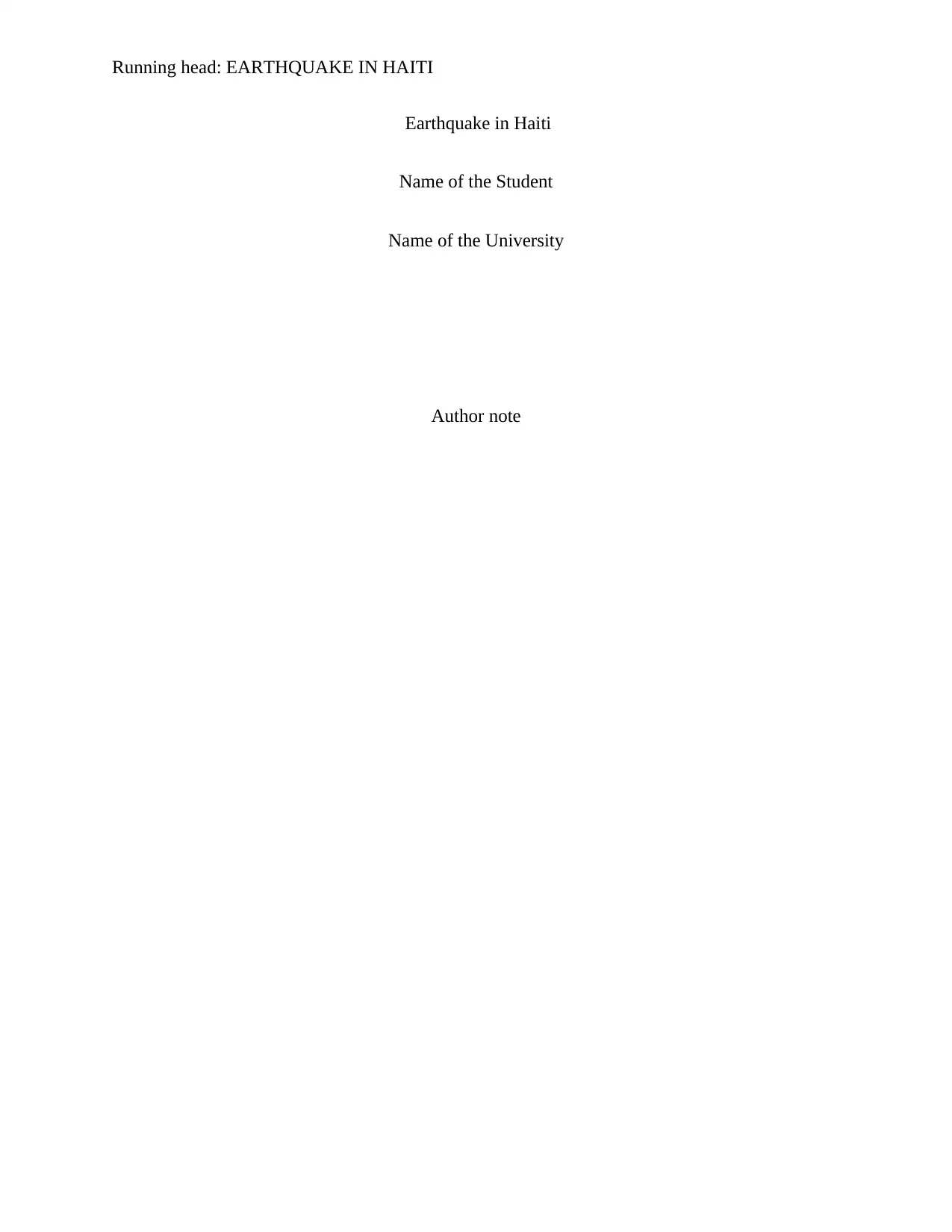
Running head: EARTHQUAKE IN HAITI
Earthquake in Haiti
Name of the Student
Name of the University
Author note
Earthquake in Haiti
Name of the Student
Name of the University
Author note
Secure Best Marks with AI Grader
Need help grading? Try our AI Grader for instant feedback on your assignments.
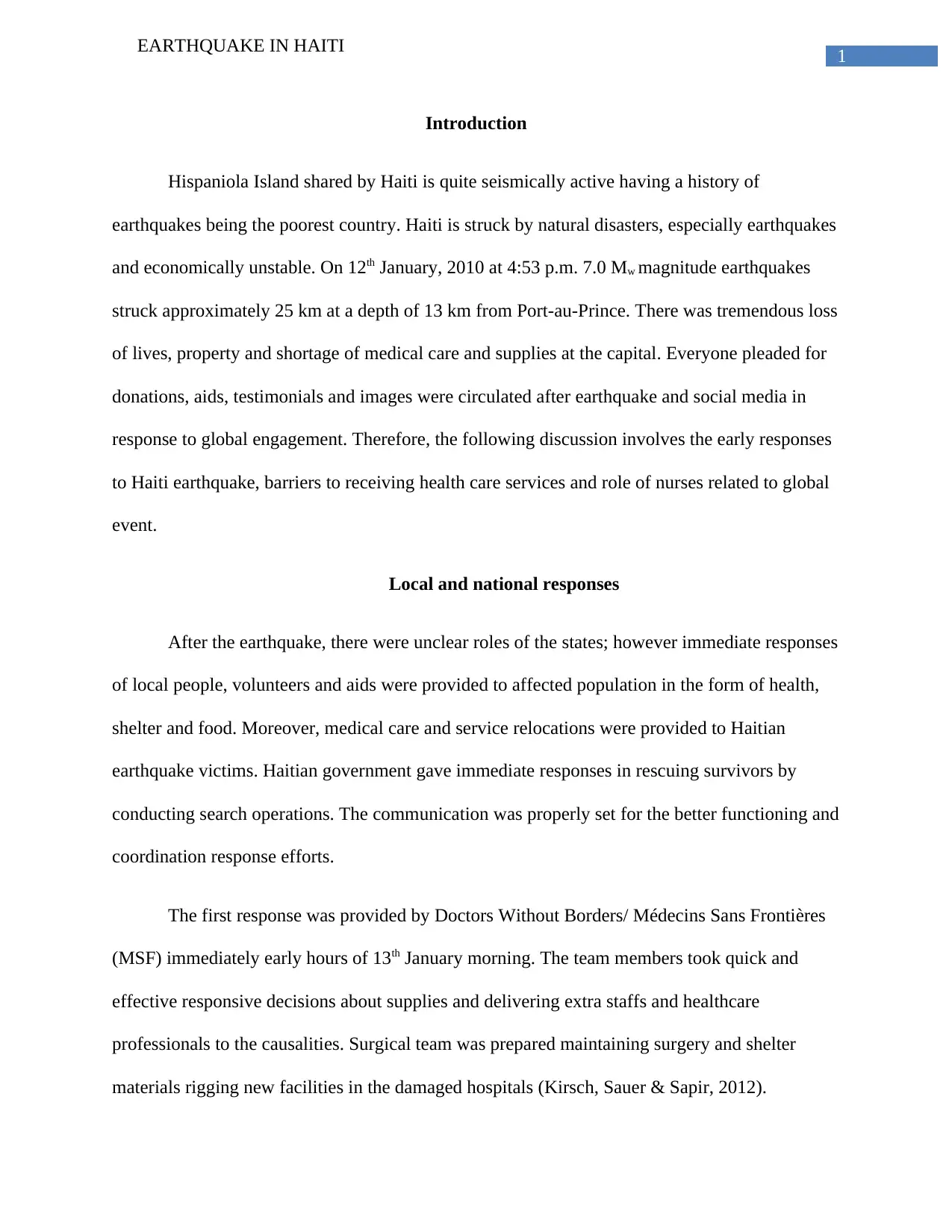
1
EARTHQUAKE IN HAITI
Introduction
Hispaniola Island shared by Haiti is quite seismically active having a history of
earthquakes being the poorest country. Haiti is struck by natural disasters, especially earthquakes
and economically unstable. On 12th January, 2010 at 4:53 p.m. 7.0 Mw magnitude earthquakes
struck approximately 25 km at a depth of 13 km from Port-au-Prince. There was tremendous loss
of lives, property and shortage of medical care and supplies at the capital. Everyone pleaded for
donations, aids, testimonials and images were circulated after earthquake and social media in
response to global engagement. Therefore, the following discussion involves the early responses
to Haiti earthquake, barriers to receiving health care services and role of nurses related to global
event.
Local and national responses
After the earthquake, there were unclear roles of the states; however immediate responses
of local people, volunteers and aids were provided to affected population in the form of health,
shelter and food. Moreover, medical care and service relocations were provided to Haitian
earthquake victims. Haitian government gave immediate responses in rescuing survivors by
conducting search operations. The communication was properly set for the better functioning and
coordination response efforts.
The first response was provided by Doctors Without Borders/ Médecins Sans Frontières
(MSF) immediately early hours of 13th January morning. The team members took quick and
effective responsive decisions about supplies and delivering extra staffs and healthcare
professionals to the causalities. Surgical team was prepared maintaining surgery and shelter
materials rigging new facilities in the damaged hospitals (Kirsch, Sauer & Sapir, 2012).
EARTHQUAKE IN HAITI
Introduction
Hispaniola Island shared by Haiti is quite seismically active having a history of
earthquakes being the poorest country. Haiti is struck by natural disasters, especially earthquakes
and economically unstable. On 12th January, 2010 at 4:53 p.m. 7.0 Mw magnitude earthquakes
struck approximately 25 km at a depth of 13 km from Port-au-Prince. There was tremendous loss
of lives, property and shortage of medical care and supplies at the capital. Everyone pleaded for
donations, aids, testimonials and images were circulated after earthquake and social media in
response to global engagement. Therefore, the following discussion involves the early responses
to Haiti earthquake, barriers to receiving health care services and role of nurses related to global
event.
Local and national responses
After the earthquake, there were unclear roles of the states; however immediate responses
of local people, volunteers and aids were provided to affected population in the form of health,
shelter and food. Moreover, medical care and service relocations were provided to Haitian
earthquake victims. Haitian government gave immediate responses in rescuing survivors by
conducting search operations. The communication was properly set for the better functioning and
coordination response efforts.
The first response was provided by Doctors Without Borders/ Médecins Sans Frontières
(MSF) immediately early hours of 13th January morning. The team members took quick and
effective responsive decisions about supplies and delivering extra staffs and healthcare
professionals to the causalities. Surgical team was prepared maintaining surgery and shelter
materials rigging new facilities in the damaged hospitals (Kirsch, Sauer & Sapir, 2012).
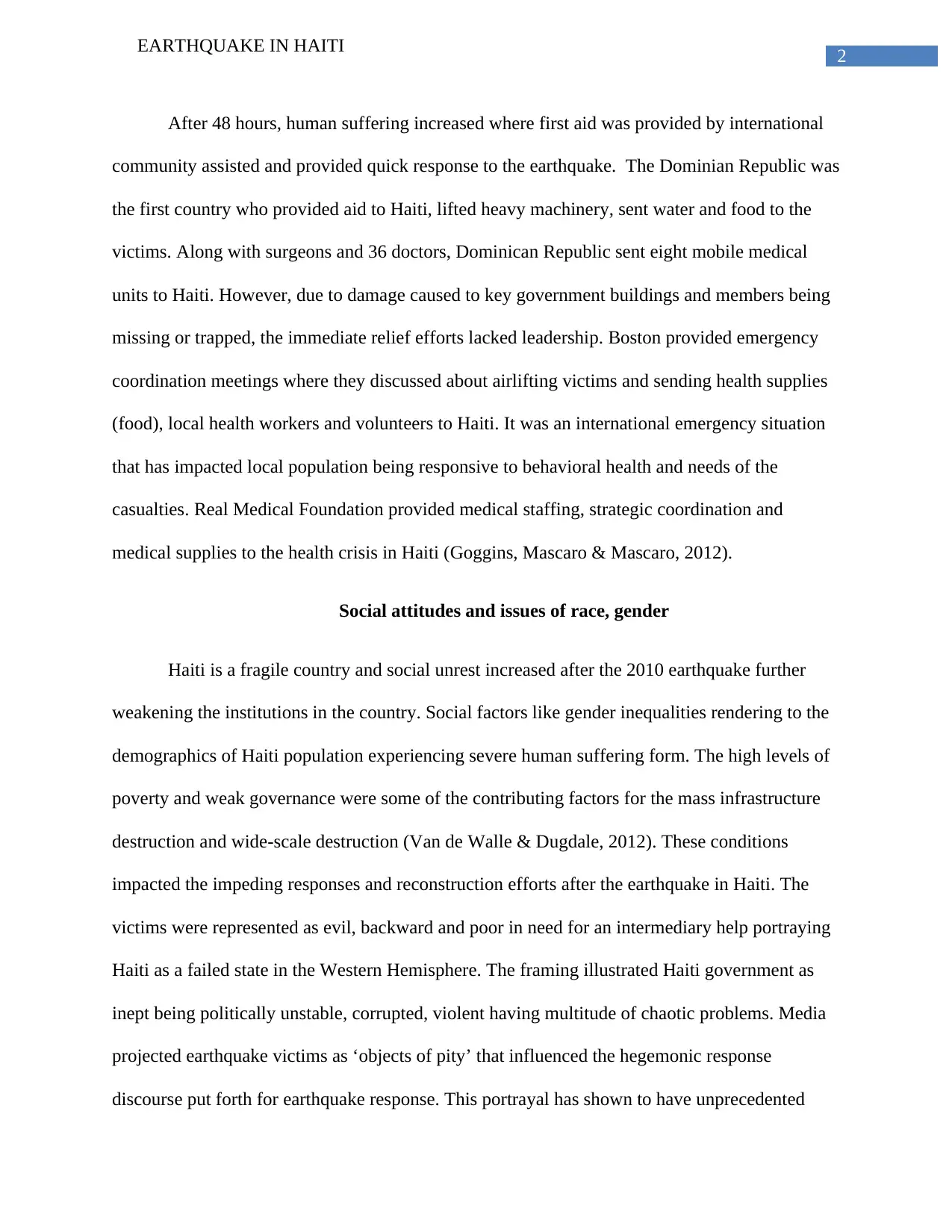
2
EARTHQUAKE IN HAITI
After 48 hours, human suffering increased where first aid was provided by international
community assisted and provided quick response to the earthquake. The Dominian Republic was
the first country who provided aid to Haiti, lifted heavy machinery, sent water and food to the
victims. Along with surgeons and 36 doctors, Dominican Republic sent eight mobile medical
units to Haiti. However, due to damage caused to key government buildings and members being
missing or trapped, the immediate relief efforts lacked leadership. Boston provided emergency
coordination meetings where they discussed about airlifting victims and sending health supplies
(food), local health workers and volunteers to Haiti. It was an international emergency situation
that has impacted local population being responsive to behavioral health and needs of the
casualties. Real Medical Foundation provided medical staffing, strategic coordination and
medical supplies to the health crisis in Haiti (Goggins, Mascaro & Mascaro, 2012).
Social attitudes and issues of race, gender
Haiti is a fragile country and social unrest increased after the 2010 earthquake further
weakening the institutions in the country. Social factors like gender inequalities rendering to the
demographics of Haiti population experiencing severe human suffering form. The high levels of
poverty and weak governance were some of the contributing factors for the mass infrastructure
destruction and wide-scale destruction (Van de Walle & Dugdale, 2012). These conditions
impacted the impeding responses and reconstruction efforts after the earthquake in Haiti. The
victims were represented as evil, backward and poor in need for an intermediary help portraying
Haiti as a failed state in the Western Hemisphere. The framing illustrated Haiti government as
inept being politically unstable, corrupted, violent having multitude of chaotic problems. Media
projected earthquake victims as ‘objects of pity’ that influenced the hegemonic response
discourse put forth for earthquake response. This portrayal has shown to have unprecedented
EARTHQUAKE IN HAITI
After 48 hours, human suffering increased where first aid was provided by international
community assisted and provided quick response to the earthquake. The Dominian Republic was
the first country who provided aid to Haiti, lifted heavy machinery, sent water and food to the
victims. Along with surgeons and 36 doctors, Dominican Republic sent eight mobile medical
units to Haiti. However, due to damage caused to key government buildings and members being
missing or trapped, the immediate relief efforts lacked leadership. Boston provided emergency
coordination meetings where they discussed about airlifting victims and sending health supplies
(food), local health workers and volunteers to Haiti. It was an international emergency situation
that has impacted local population being responsive to behavioral health and needs of the
casualties. Real Medical Foundation provided medical staffing, strategic coordination and
medical supplies to the health crisis in Haiti (Goggins, Mascaro & Mascaro, 2012).
Social attitudes and issues of race, gender
Haiti is a fragile country and social unrest increased after the 2010 earthquake further
weakening the institutions in the country. Social factors like gender inequalities rendering to the
demographics of Haiti population experiencing severe human suffering form. The high levels of
poverty and weak governance were some of the contributing factors for the mass infrastructure
destruction and wide-scale destruction (Van de Walle & Dugdale, 2012). These conditions
impacted the impeding responses and reconstruction efforts after the earthquake in Haiti. The
victims were represented as evil, backward and poor in need for an intermediary help portraying
Haiti as a failed state in the Western Hemisphere. The framing illustrated Haiti government as
inept being politically unstable, corrupted, violent having multitude of chaotic problems. Media
projected earthquake victims as ‘objects of pity’ that influenced the hegemonic response
discourse put forth for earthquake response. This portrayal has shown to have unprecedented
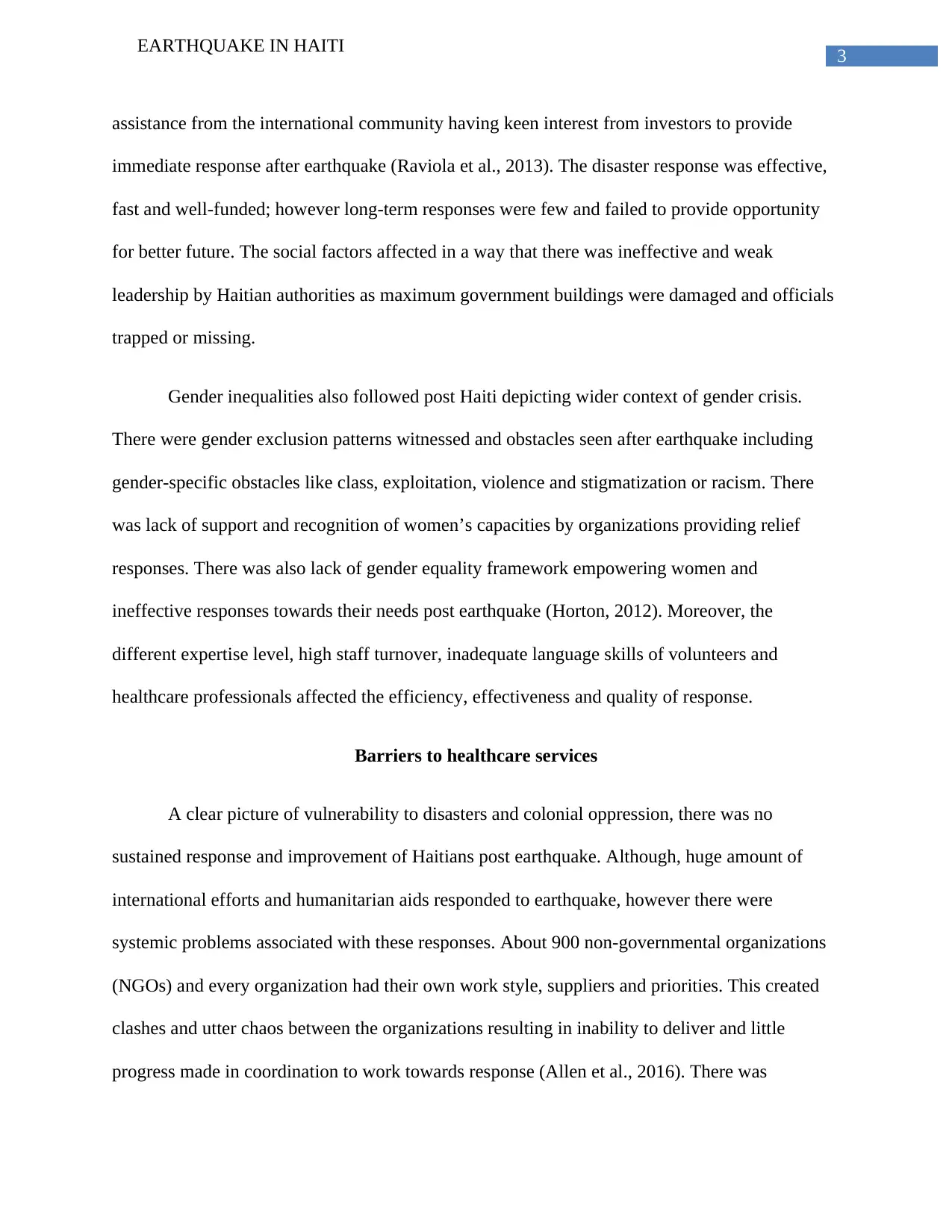
3
EARTHQUAKE IN HAITI
assistance from the international community having keen interest from investors to provide
immediate response after earthquake (Raviola et al., 2013). The disaster response was effective,
fast and well-funded; however long-term responses were few and failed to provide opportunity
for better future. The social factors affected in a way that there was ineffective and weak
leadership by Haitian authorities as maximum government buildings were damaged and officials
trapped or missing.
Gender inequalities also followed post Haiti depicting wider context of gender crisis.
There were gender exclusion patterns witnessed and obstacles seen after earthquake including
gender-specific obstacles like class, exploitation, violence and stigmatization or racism. There
was lack of support and recognition of women’s capacities by organizations providing relief
responses. There was also lack of gender equality framework empowering women and
ineffective responses towards their needs post earthquake (Horton, 2012). Moreover, the
different expertise level, high staff turnover, inadequate language skills of volunteers and
healthcare professionals affected the efficiency, effectiveness and quality of response.
Barriers to healthcare services
A clear picture of vulnerability to disasters and colonial oppression, there was no
sustained response and improvement of Haitians post earthquake. Although, huge amount of
international efforts and humanitarian aids responded to earthquake, however there were
systemic problems associated with these responses. About 900 non-governmental organizations
(NGOs) and every organization had their own work style, suppliers and priorities. This created
clashes and utter chaos between the organizations resulting in inability to deliver and little
progress made in coordination to work towards response (Allen et al., 2016). There was
EARTHQUAKE IN HAITI
assistance from the international community having keen interest from investors to provide
immediate response after earthquake (Raviola et al., 2013). The disaster response was effective,
fast and well-funded; however long-term responses were few and failed to provide opportunity
for better future. The social factors affected in a way that there was ineffective and weak
leadership by Haitian authorities as maximum government buildings were damaged and officials
trapped or missing.
Gender inequalities also followed post Haiti depicting wider context of gender crisis.
There were gender exclusion patterns witnessed and obstacles seen after earthquake including
gender-specific obstacles like class, exploitation, violence and stigmatization or racism. There
was lack of support and recognition of women’s capacities by organizations providing relief
responses. There was also lack of gender equality framework empowering women and
ineffective responses towards their needs post earthquake (Horton, 2012). Moreover, the
different expertise level, high staff turnover, inadequate language skills of volunteers and
healthcare professionals affected the efficiency, effectiveness and quality of response.
Barriers to healthcare services
A clear picture of vulnerability to disasters and colonial oppression, there was no
sustained response and improvement of Haitians post earthquake. Although, huge amount of
international efforts and humanitarian aids responded to earthquake, however there were
systemic problems associated with these responses. About 900 non-governmental organizations
(NGOs) and every organization had their own work style, suppliers and priorities. This created
clashes and utter chaos between the organizations resulting in inability to deliver and little
progress made in coordination to work towards response (Allen et al., 2016). There was
Secure Best Marks with AI Grader
Need help grading? Try our AI Grader for instant feedback on your assignments.
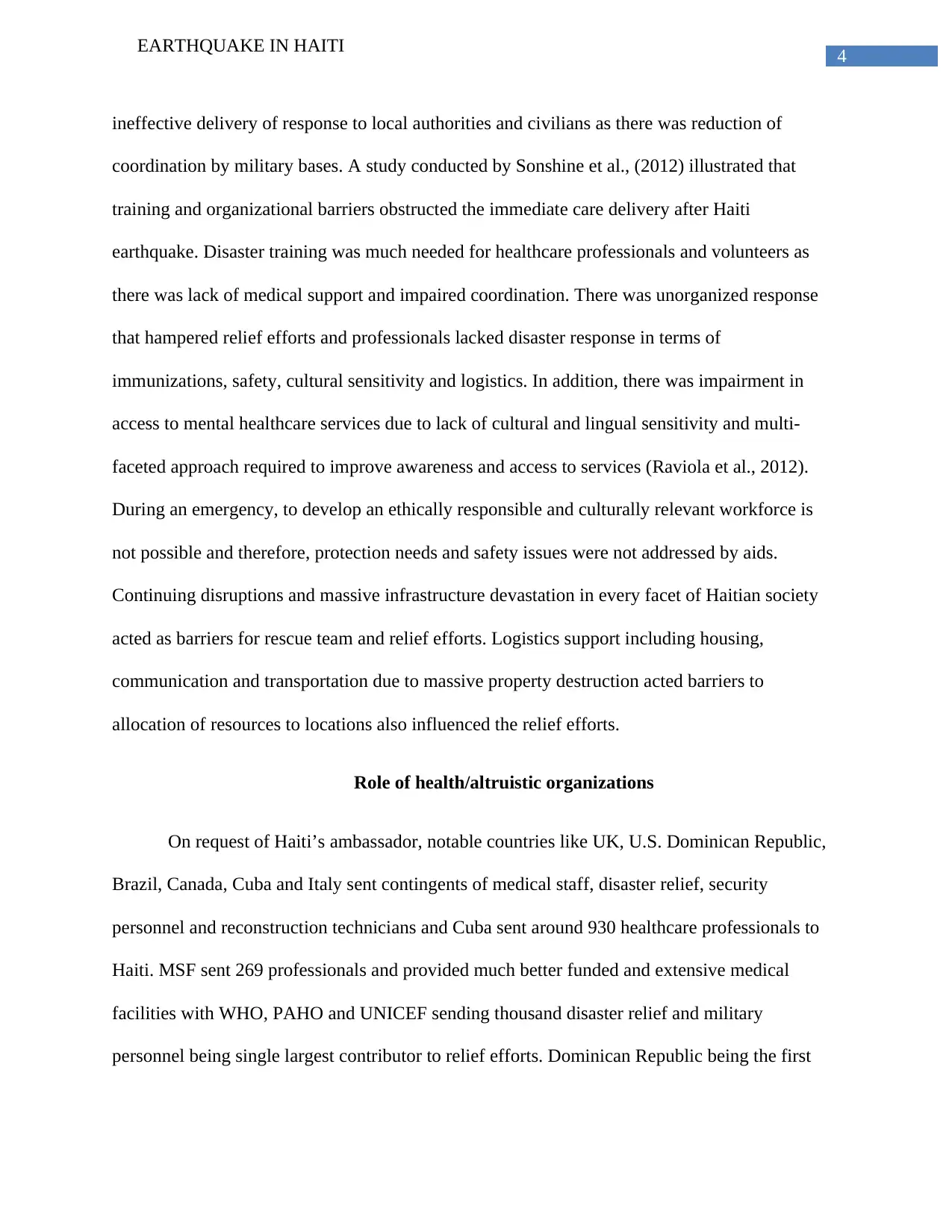
4
EARTHQUAKE IN HAITI
ineffective delivery of response to local authorities and civilians as there was reduction of
coordination by military bases. A study conducted by Sonshine et al., (2012) illustrated that
training and organizational barriers obstructed the immediate care delivery after Haiti
earthquake. Disaster training was much needed for healthcare professionals and volunteers as
there was lack of medical support and impaired coordination. There was unorganized response
that hampered relief efforts and professionals lacked disaster response in terms of
immunizations, safety, cultural sensitivity and logistics. In addition, there was impairment in
access to mental healthcare services due to lack of cultural and lingual sensitivity and multi-
faceted approach required to improve awareness and access to services (Raviola et al., 2012).
During an emergency, to develop an ethically responsible and culturally relevant workforce is
not possible and therefore, protection needs and safety issues were not addressed by aids.
Continuing disruptions and massive infrastructure devastation in every facet of Haitian society
acted as barriers for rescue team and relief efforts. Logistics support including housing,
communication and transportation due to massive property destruction acted barriers to
allocation of resources to locations also influenced the relief efforts.
Role of health/altruistic organizations
On request of Haiti’s ambassador, notable countries like UK, U.S. Dominican Republic,
Brazil, Canada, Cuba and Italy sent contingents of medical staff, disaster relief, security
personnel and reconstruction technicians and Cuba sent around 930 healthcare professionals to
Haiti. MSF sent 269 professionals and provided much better funded and extensive medical
facilities with WHO, PAHO and UNICEF sending thousand disaster relief and military
personnel being single largest contributor to relief efforts. Dominican Republic being the first
EARTHQUAKE IN HAITI
ineffective delivery of response to local authorities and civilians as there was reduction of
coordination by military bases. A study conducted by Sonshine et al., (2012) illustrated that
training and organizational barriers obstructed the immediate care delivery after Haiti
earthquake. Disaster training was much needed for healthcare professionals and volunteers as
there was lack of medical support and impaired coordination. There was unorganized response
that hampered relief efforts and professionals lacked disaster response in terms of
immunizations, safety, cultural sensitivity and logistics. In addition, there was impairment in
access to mental healthcare services due to lack of cultural and lingual sensitivity and multi-
faceted approach required to improve awareness and access to services (Raviola et al., 2012).
During an emergency, to develop an ethically responsible and culturally relevant workforce is
not possible and therefore, protection needs and safety issues were not addressed by aids.
Continuing disruptions and massive infrastructure devastation in every facet of Haitian society
acted as barriers for rescue team and relief efforts. Logistics support including housing,
communication and transportation due to massive property destruction acted barriers to
allocation of resources to locations also influenced the relief efforts.
Role of health/altruistic organizations
On request of Haiti’s ambassador, notable countries like UK, U.S. Dominican Republic,
Brazil, Canada, Cuba and Italy sent contingents of medical staff, disaster relief, security
personnel and reconstruction technicians and Cuba sent around 930 healthcare professionals to
Haiti. MSF sent 269 professionals and provided much better funded and extensive medical
facilities with WHO, PAHO and UNICEF sending thousand disaster relief and military
personnel being single largest contributor to relief efforts. Dominican Republic being the first

5
EARTHQUAKE IN HAITI
country mobilized resources and provided aid to rescue Haitians (Holguín-Veras, Jaller &
Wachtendorf, 2012).
Volunteers were deployed that met the partner and hospital needs working in
coordination with local health clinics and facilities in supplying food, filed clinics set-up,
physical therapy support and coordinated mobile outreaches to relief camps. Altruistic
organizations in response to earthquake were American Red Cross (ARC) and Giving Children
Hope provided supplies and medicines to the casualties, provided emergency care and
humanitarian aids to Haiti. The Humanitarian Coalition reached to victims through donor
program supporting recovery and reconstruction efforts with large influx of remarkable primary
care (Altay & Labonte, 2014).
Role of nursing professionals
Nurses assisted in Haitian earthquake responded generously to emergency assistance and
calls. Not every nurse was willing to respond, however many nurses worked beyond their scope
of practice. Nurses provided care to earthquake victims in relief camps and focused on
orthopaedic injuries like dislocations and fractures and infected wounds. This nursing role was
drastically different from their traditional roles where they worked lots of casts and wound
debridement. However, there was inability to patient follow-up due to huge number of casualties
became of source of frustration for team where it was ‘hit-and-run medicine’. There was proper
wound management by nurses performing wound cleaning and fracture immobilization on
victims (Sapat & Esnard, 2012). California-based nationwide nurses' union performed pin care,
wound care and percutaneous endoscopic gastrostomy feedings and also personal care tasks.
Paediatric nurse practitioner treated diarrheal illnesses as they were secondary infections due to
EARTHQUAKE IN HAITI
country mobilized resources and provided aid to rescue Haitians (Holguín-Veras, Jaller &
Wachtendorf, 2012).
Volunteers were deployed that met the partner and hospital needs working in
coordination with local health clinics and facilities in supplying food, filed clinics set-up,
physical therapy support and coordinated mobile outreaches to relief camps. Altruistic
organizations in response to earthquake were American Red Cross (ARC) and Giving Children
Hope provided supplies and medicines to the casualties, provided emergency care and
humanitarian aids to Haiti. The Humanitarian Coalition reached to victims through donor
program supporting recovery and reconstruction efforts with large influx of remarkable primary
care (Altay & Labonte, 2014).
Role of nursing professionals
Nurses assisted in Haitian earthquake responded generously to emergency assistance and
calls. Not every nurse was willing to respond, however many nurses worked beyond their scope
of practice. Nurses provided care to earthquake victims in relief camps and focused on
orthopaedic injuries like dislocations and fractures and infected wounds. This nursing role was
drastically different from their traditional roles where they worked lots of casts and wound
debridement. However, there was inability to patient follow-up due to huge number of casualties
became of source of frustration for team where it was ‘hit-and-run medicine’. There was proper
wound management by nurses performing wound cleaning and fracture immobilization on
victims (Sapat & Esnard, 2012). California-based nationwide nurses' union performed pin care,
wound care and percutaneous endoscopic gastrostomy feedings and also personal care tasks.
Paediatric nurse practitioner treated diarrheal illnesses as they were secondary infections due to
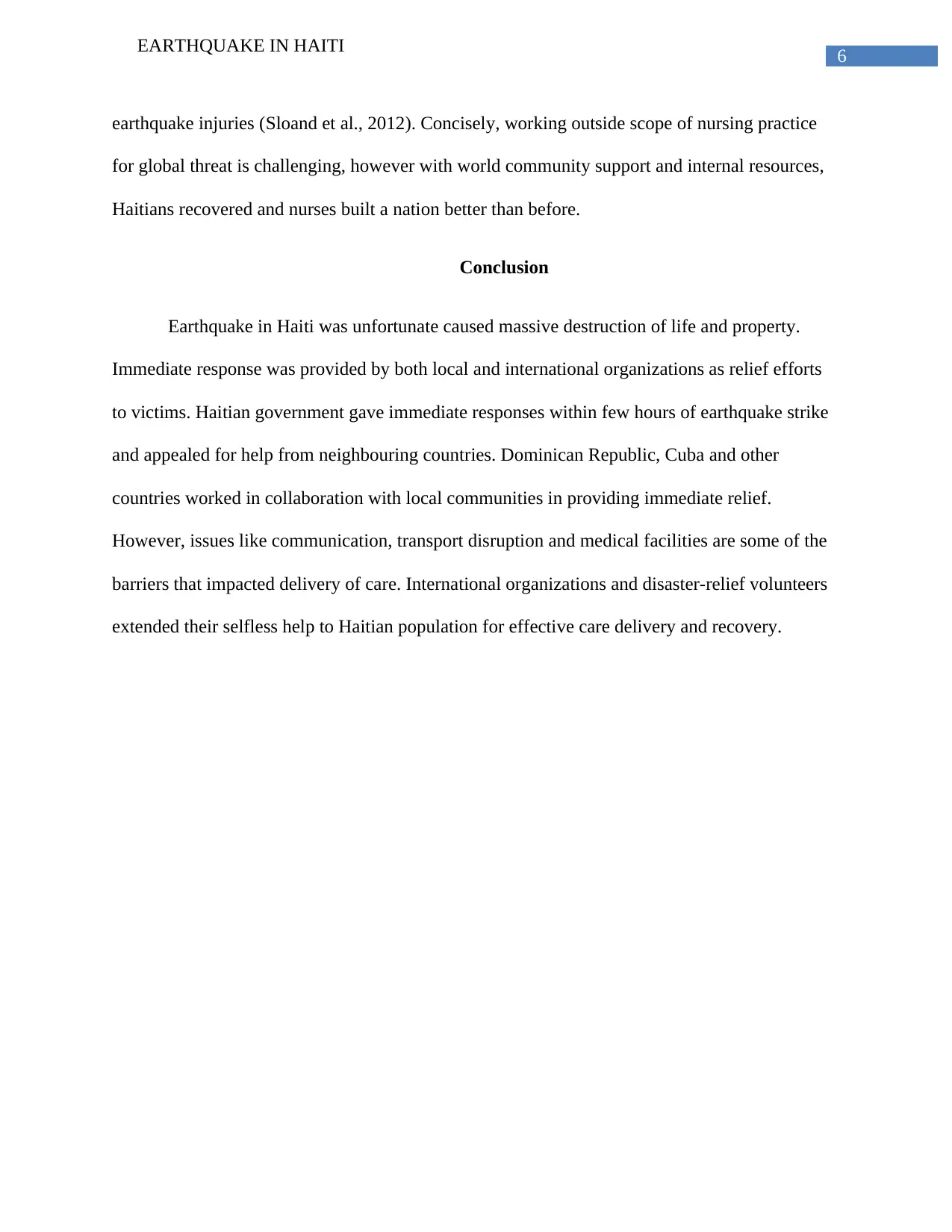
6
EARTHQUAKE IN HAITI
earthquake injuries (Sloand et al., 2012). Concisely, working outside scope of nursing practice
for global threat is challenging, however with world community support and internal resources,
Haitians recovered and nurses built a nation better than before.
Conclusion
Earthquake in Haiti was unfortunate caused massive destruction of life and property.
Immediate response was provided by both local and international organizations as relief efforts
to victims. Haitian government gave immediate responses within few hours of earthquake strike
and appealed for help from neighbouring countries. Dominican Republic, Cuba and other
countries worked in collaboration with local communities in providing immediate relief.
However, issues like communication, transport disruption and medical facilities are some of the
barriers that impacted delivery of care. International organizations and disaster-relief volunteers
extended their selfless help to Haitian population for effective care delivery and recovery.
EARTHQUAKE IN HAITI
earthquake injuries (Sloand et al., 2012). Concisely, working outside scope of nursing practice
for global threat is challenging, however with world community support and internal resources,
Haitians recovered and nurses built a nation better than before.
Conclusion
Earthquake in Haiti was unfortunate caused massive destruction of life and property.
Immediate response was provided by both local and international organizations as relief efforts
to victims. Haitian government gave immediate responses within few hours of earthquake strike
and appealed for help from neighbouring countries. Dominican Republic, Cuba and other
countries worked in collaboration with local communities in providing immediate relief.
However, issues like communication, transport disruption and medical facilities are some of the
barriers that impacted delivery of care. International organizations and disaster-relief volunteers
extended their selfless help to Haitian population for effective care delivery and recovery.
Paraphrase This Document
Need a fresh take? Get an instant paraphrase of this document with our AI Paraphraser
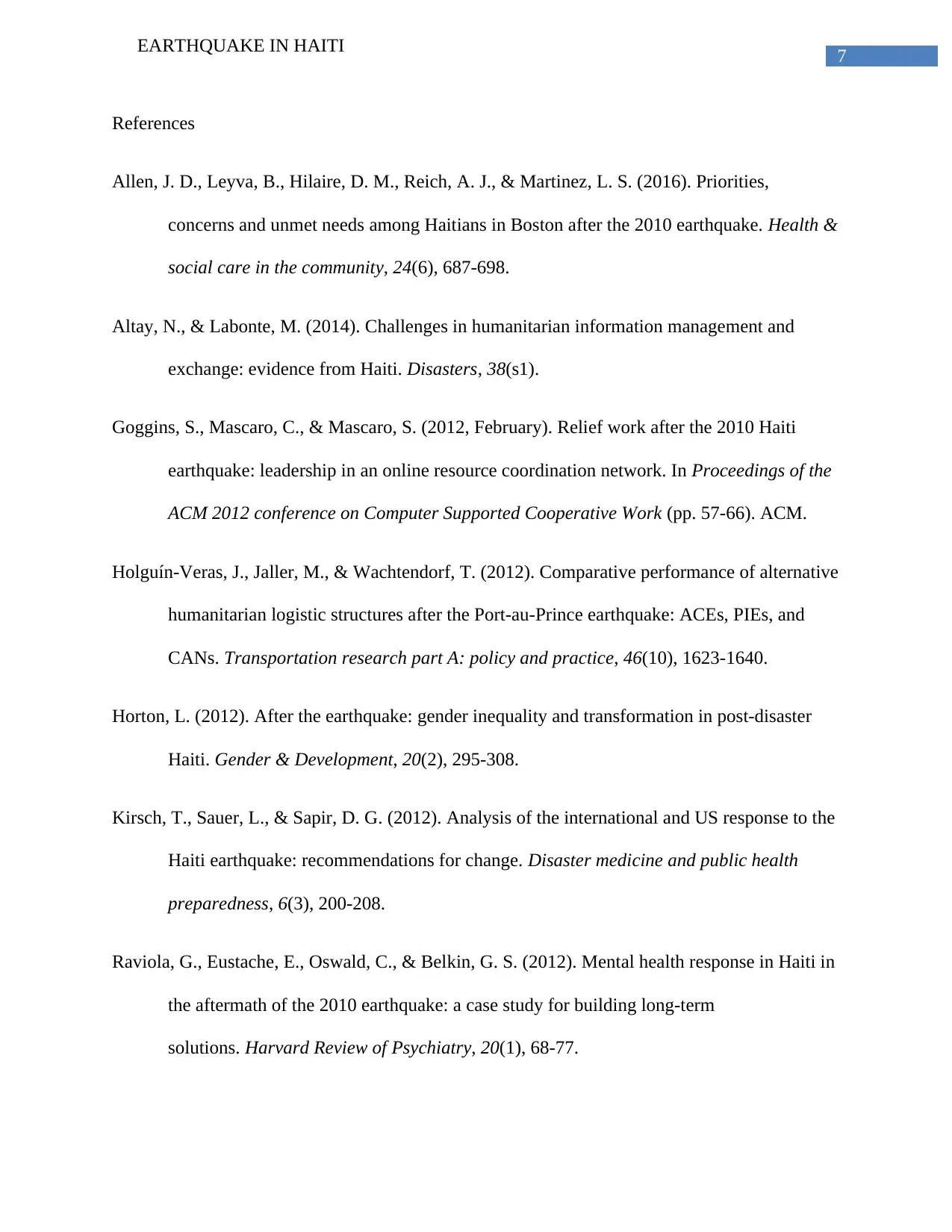
7
EARTHQUAKE IN HAITI
References
Allen, J. D., Leyva, B., Hilaire, D. M., Reich, A. J., & Martinez, L. S. (2016). Priorities,
concerns and unmet needs among Haitians in Boston after the 2010 earthquake. Health &
social care in the community, 24(6), 687-698.
Altay, N., & Labonte, M. (2014). Challenges in humanitarian information management and
exchange: evidence from Haiti. Disasters, 38(s1).
Goggins, S., Mascaro, C., & Mascaro, S. (2012, February). Relief work after the 2010 Haiti
earthquake: leadership in an online resource coordination network. In Proceedings of the
ACM 2012 conference on Computer Supported Cooperative Work (pp. 57-66). ACM.
Holguín-Veras, J., Jaller, M., & Wachtendorf, T. (2012). Comparative performance of alternative
humanitarian logistic structures after the Port-au-Prince earthquake: ACEs, PIEs, and
CANs. Transportation research part A: policy and practice, 46(10), 1623-1640.
Horton, L. (2012). After the earthquake: gender inequality and transformation in post-disaster
Haiti. Gender & Development, 20(2), 295-308.
Kirsch, T., Sauer, L., & Sapir, D. G. (2012). Analysis of the international and US response to the
Haiti earthquake: recommendations for change. Disaster medicine and public health
preparedness, 6(3), 200-208.
Raviola, G., Eustache, E., Oswald, C., & Belkin, G. S. (2012). Mental health response in Haiti in
the aftermath of the 2010 earthquake: a case study for building long-term
solutions. Harvard Review of Psychiatry, 20(1), 68-77.
EARTHQUAKE IN HAITI
References
Allen, J. D., Leyva, B., Hilaire, D. M., Reich, A. J., & Martinez, L. S. (2016). Priorities,
concerns and unmet needs among Haitians in Boston after the 2010 earthquake. Health &
social care in the community, 24(6), 687-698.
Altay, N., & Labonte, M. (2014). Challenges in humanitarian information management and
exchange: evidence from Haiti. Disasters, 38(s1).
Goggins, S., Mascaro, C., & Mascaro, S. (2012, February). Relief work after the 2010 Haiti
earthquake: leadership in an online resource coordination network. In Proceedings of the
ACM 2012 conference on Computer Supported Cooperative Work (pp. 57-66). ACM.
Holguín-Veras, J., Jaller, M., & Wachtendorf, T. (2012). Comparative performance of alternative
humanitarian logistic structures after the Port-au-Prince earthquake: ACEs, PIEs, and
CANs. Transportation research part A: policy and practice, 46(10), 1623-1640.
Horton, L. (2012). After the earthquake: gender inequality and transformation in post-disaster
Haiti. Gender & Development, 20(2), 295-308.
Kirsch, T., Sauer, L., & Sapir, D. G. (2012). Analysis of the international and US response to the
Haiti earthquake: recommendations for change. Disaster medicine and public health
preparedness, 6(3), 200-208.
Raviola, G., Eustache, E., Oswald, C., & Belkin, G. S. (2012). Mental health response in Haiti in
the aftermath of the 2010 earthquake: a case study for building long-term
solutions. Harvard Review of Psychiatry, 20(1), 68-77.
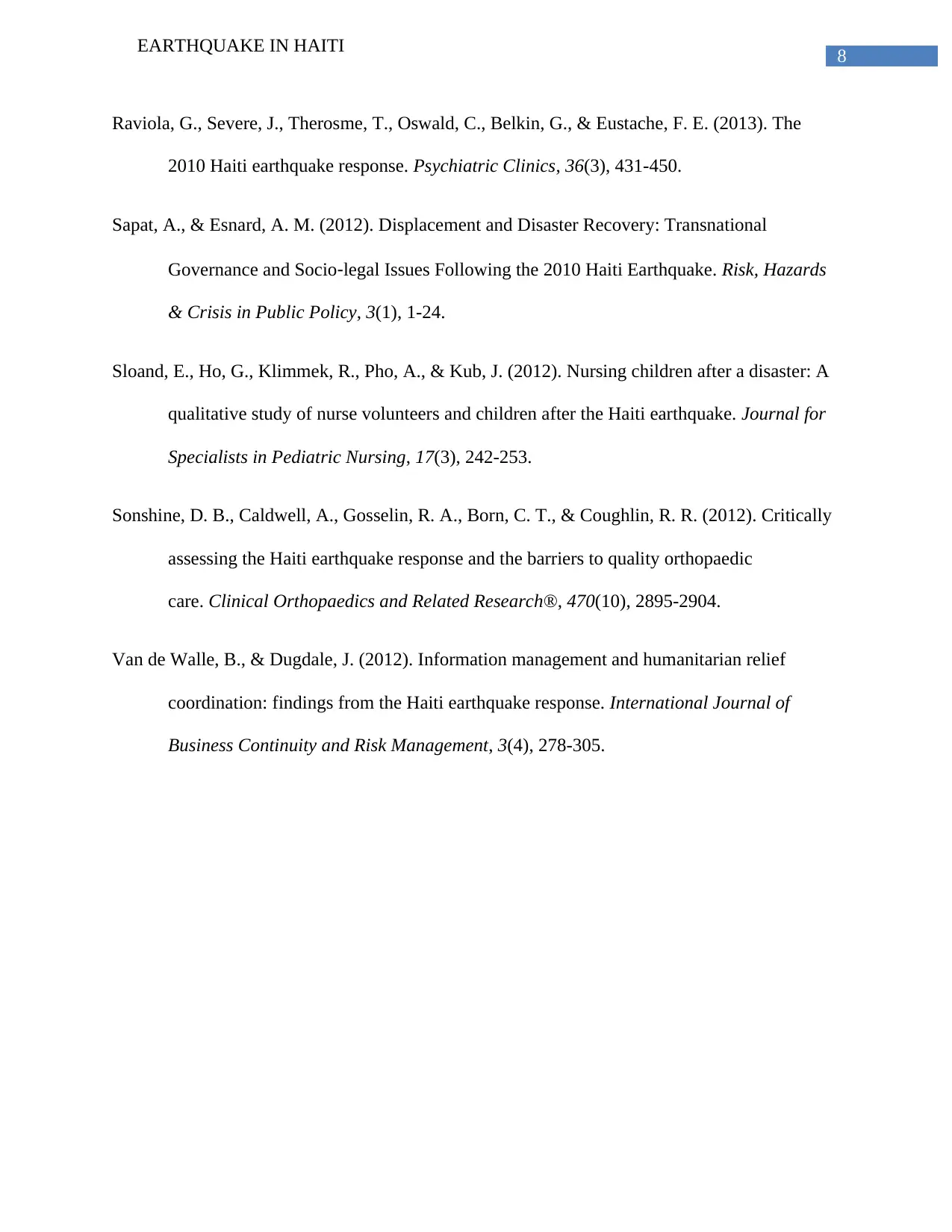
8
EARTHQUAKE IN HAITI
Raviola, G., Severe, J., Therosme, T., Oswald, C., Belkin, G., & Eustache, F. E. (2013). The
2010 Haiti earthquake response. Psychiatric Clinics, 36(3), 431-450.
Sapat, A., & Esnard, A. M. (2012). Displacement and Disaster Recovery: Transnational
Governance and Socio‐legal Issues Following the 2010 Haiti Earthquake. Risk, Hazards
& Crisis in Public Policy, 3(1), 1-24.
Sloand, E., Ho, G., Klimmek, R., Pho, A., & Kub, J. (2012). Nursing children after a disaster: A
qualitative study of nurse volunteers and children after the Haiti earthquake. Journal for
Specialists in Pediatric Nursing, 17(3), 242-253.
Sonshine, D. B., Caldwell, A., Gosselin, R. A., Born, C. T., & Coughlin, R. R. (2012). Critically
assessing the Haiti earthquake response and the barriers to quality orthopaedic
care. Clinical Orthopaedics and Related Research®, 470(10), 2895-2904.
Van de Walle, B., & Dugdale, J. (2012). Information management and humanitarian relief
coordination: findings from the Haiti earthquake response. International Journal of
Business Continuity and Risk Management, 3(4), 278-305.
EARTHQUAKE IN HAITI
Raviola, G., Severe, J., Therosme, T., Oswald, C., Belkin, G., & Eustache, F. E. (2013). The
2010 Haiti earthquake response. Psychiatric Clinics, 36(3), 431-450.
Sapat, A., & Esnard, A. M. (2012). Displacement and Disaster Recovery: Transnational
Governance and Socio‐legal Issues Following the 2010 Haiti Earthquake. Risk, Hazards
& Crisis in Public Policy, 3(1), 1-24.
Sloand, E., Ho, G., Klimmek, R., Pho, A., & Kub, J. (2012). Nursing children after a disaster: A
qualitative study of nurse volunteers and children after the Haiti earthquake. Journal for
Specialists in Pediatric Nursing, 17(3), 242-253.
Sonshine, D. B., Caldwell, A., Gosselin, R. A., Born, C. T., & Coughlin, R. R. (2012). Critically
assessing the Haiti earthquake response and the barriers to quality orthopaedic
care. Clinical Orthopaedics and Related Research®, 470(10), 2895-2904.
Van de Walle, B., & Dugdale, J. (2012). Information management and humanitarian relief
coordination: findings from the Haiti earthquake response. International Journal of
Business Continuity and Risk Management, 3(4), 278-305.
1 out of 9
Related Documents
Your All-in-One AI-Powered Toolkit for Academic Success.
+13062052269
info@desklib.com
Available 24*7 on WhatsApp / Email
![[object Object]](/_next/static/media/star-bottom.7253800d.svg)
Unlock your academic potential
© 2024 | Zucol Services PVT LTD | All rights reserved.



